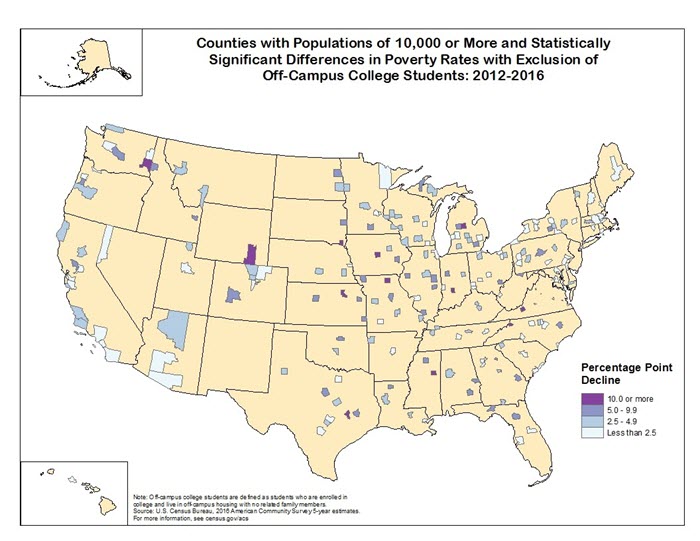Examining the Effect of Off-Campus College Students on Poverty Rates
Examining the Effect of Off-Campus College Students on Poverty Rates
The U.S. Census Bureau’s American Community Survey 5-year estimates give users the tools and ability to ask and answer many questions. One interesting question is how different populations affect an area’s poverty rate.
For example, how do college students, specifically students living off-campus, affect poverty rates in the places they live while enrolled in school? Earlier Census Bureau research investigated the impact of off-campus college students on community poverty rates and found that smaller communities were more likely to have poverty rates affected by students. (Students living on campus are not included in the poverty universe and therefore do not impact poverty rates).
Using data from the 2012-2016 American Community Survey five-year estimates, we have updated this research with the release of two tables that list all counties and places with more than 10,000 residents where the presence of off-campus students significantly impacts poverty rates. The findings, similar to earlier research, show that the presence of large numbers of off-campus college students can affect an area’s poverty rate.
Source: 2012-2016 American Community Survey 5-year Estimates.
The map and detailed tables online display all counties with populations above 10,000 that had statistically significant differences between their original poverty rates and their rates when adjusted to exclude college students living off campus.
Of the 2,437 counties in the United States with populations above 10,000, 211 counties (8.7 percent) had statistically significant decreases in their poverty rate when excluding off-campus college students. Excluding off-campus college students did not result in increased poverty rates in any of these counties. We find poverty rates are impacted by off-campus students in both small counties that house large universities, as well as in some of the largest counties in the United States, many of which are home to multiple colleges and universities. In fact, 87 of the 100 largest colleges and universities based on on-site enrollment are located within these 211 counties.
The map shows a geographic representation of the 211 counties with statistically significant changes. The majority of these counties had decreases of 5 percentage points or less (157 counties or 74.4 percent of all counties that experienced a decline). A smaller number of counties had a 10 percentage point or more decrease from the original poverty rate (16 counties or 7.6 percent of all counties that experienced a decline). These counties with the largest differences tended to have smaller total populations.
An additional table shows places with populations greater than 10,000 people that had statistically significant differences between their original and adjusted poverty rates. Of these 3,943 places, 226 (5.7 percent) had significant declines in poverty rates with the exclusion of off-campus college students. Poverty rates did not increase for any of these places as a result of excluding off-campus college students. Of the 100 largest on-site enrollment colleges and universities, 81 were located in places that showed a significant impact of college students on poverty rates.
The estimates and figures presented here are designed to stimulate further thought about how college students impact poverty rates, and how those estimates might be interpreted in those communities. In a number of areas, the inclusion of off-campus students had a statistically significant effect on local poverty rates, in some cases increasing the rate by 10 or more percentage points.




